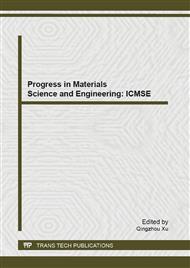p.221
p.227
p.233
p.240
p.246
p.251
p.256
p.262
p.268
The Effects of SiO2/PEG Suspension on Mechanical Properties of Rigid Polyurethane Foams
Abstract:
In order to improve the mechanical properties of the polyurethane foams, the silica nanoparticles were added into the foams in the form of SiO2/PEG suspension during the preparation process. The microstructure, density, static mechanical properties and dynamic mechanical properties of the foams were investigated. Microstructure analysis shows that the silica nanoparticles were uniformly dispersed in the foams, however when the amounts of SiO2/PEG suspension is more than 2.5 wt.%, cracks in the skelecton were observed in foams. With the increased SiO2/PEG suspension, the density, static compression strength and dynamic compression strength show an increasing tendency. When the SiO2/PEG suspension is 2.5 wt.%, the density of the foams increased 4.17 %, while the static compression strength increased 26 %. When the SiO2/PEG suspension is 10 wt.%, the density of the foams increased 16 %, while the dynamic compression strength increased 60.5 %. The corresponding mechanism was discussed in the paper.
Info:
Periodical:
Pages:
246-250
Citation:
Online since:
October 2013
Authors:
Keywords:
Price:
Сopyright:
© 2013 Trans Tech Publications Ltd. All Rights Reserved
Share:
Citation:


